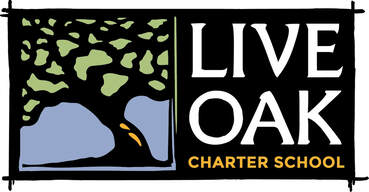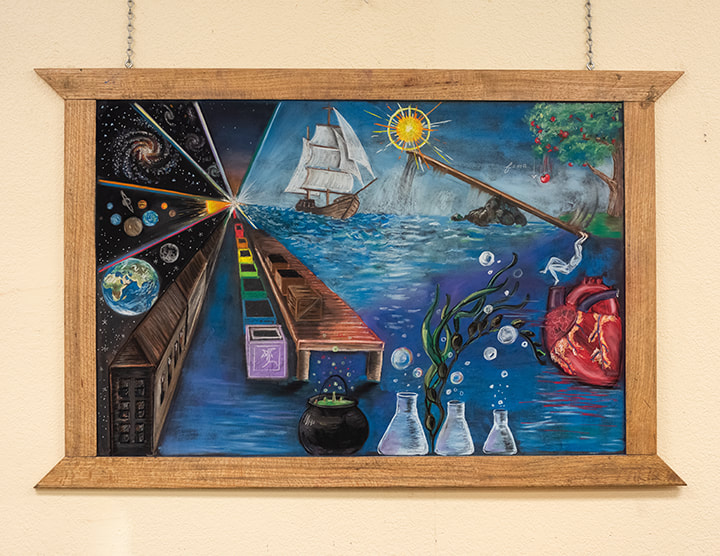Middle School Program 6th - 8th
|
Adolescence is a time of increasing self-awareness and self-expression. At this time, a child’s worldview is expanding and they long to find their place within it.
The waldorf curriculum views middle school as a time when students take responsibility for their own work and develop their unique perspective and academic voice. While large, mainstream middle schools can be a harsh place during this awkward and exciting time, the environment of Live Oak’s thoughtfully designed, artistically rich, whole-child approach to the Middle School years offers something different. |
Head • Heart • Hands
- Rigorous academics in core disciplines that develop critical thinking and development of the academic voice.
- A Team of Teachers devoted to Middle School.
- A dedicated Math Teacher (grades 6th-8th). See Math Program outlined below.
- Looping - one main lesson teacher holds the cohort (6th - 8th)
- Exceeding Next Generation Science Standards with dynamic, hands-on sciences
- Common Core-aligned
- Integrated Arts: music, drama, illustration, 3D sewing, machine sewing, painting, movement. Start where you are.
- Overnight Field trips, Campouts, adventure learning and service hours
- Social Dances with Sister Waldorf Schools (7-8)
- Spirit of Belonging. Welcome Week, Spirit Week and our very popular February Dance (6-8)
- Special projects, traditions and practices foster integral character traits, such as: The Knighting Project in 6th Grade, Multi-grade Buddies, Rose Ceremony, The Seventh Grade Play and the Eighth Grade Project. Overnight Field Trips, Adventure Learning, and much more.
- This community of students tend to be sensitive and supporting of their classmates. They are also an inclusive bunch. Many of our students have been together for a long time, so they always appreciate the opportunity to meet new kids and deepen friendships with buddies from sports, dance or horse riding.
- Good vibes. Sometimes smelly vibes, but good vibes generally speaking.
6th Grade

Sixth graders feel the influence of puberty, with themselves and in the community. As the long bones of the limbs begin their growth spurt and the children are increasingly aware of their bodies, the time is right for geology, the study of the physical body of the earth. The students at this age have a love for things delineated as absolutes; everything is experienced as black or white, and the nuances of shades of gray are distant. Roman law, black and white drawing, overcoming the physical and mental challenges of climbing Mt Lassen and Cinder Cone, and the teaching method of “compare and contrast” all speak to the developmental stage of the children.
The Roman era epitomizes historically what the children are experiencing in their bodies. Of all the ancient cultures, the Romans most strongly dominated and transformed the physical world. Whereas geometrical shapes have been drawn freehand in earlier grades, the 6th grader learns exact constructions with compass and straight-edge, and the mathematical properties of these shapes.
The Roman era epitomizes historically what the children are experiencing in their bodies. Of all the ancient cultures, the Romans most strongly dominated and transformed the physical world. Whereas geometrical shapes have been drawn freehand in earlier grades, the 6th grader learns exact constructions with compass and straight-edge, and the mathematical properties of these shapes.
6th Grade Highlight
Following suit of the Knighting Ceremony, the Medieval Tournament is a tradition within the Waldorf curriculum. It is designed to enhance and bring to life the 6th graders’ study of the Middle Ages. It gives students an experience of the physical activities people enjoyed and endured during those times and the opportunity to experience the skills and weapons used in the era, like hurling, javelin, archery and jousting. It also allows them to connect with new peers through cooperative and competitive play with other schools, and partake in a day of virtuous reverence of the period.
Following suit of the Knighting Ceremony, the Medieval Tournament is a tradition within the Waldorf curriculum. It is designed to enhance and bring to life the 6th graders’ study of the Middle Ages. It gives students an experience of the physical activities people enjoyed and endured during those times and the opportunity to experience the skills and weapons used in the era, like hurling, javelin, archery and jousting. It also allows them to connect with new peers through cooperative and competitive play with other schools, and partake in a day of virtuous reverence of the period.
7th Grade

Seventh graders are increasingly experiencing themselves as individuals with tastes and impulses of their own. They rightfully challenge accepted practices and ideas in order to understand and participate in both their school and home lives in a more independent way. The history of the Renaissance, Age of Exploration, and the Reformation meets their inner experience along with biographies of human beings who fought with the cultural life of their times in order to adhere to their own individual conscience rather than the laws of the State or the Church.
At a time when students' center of gravity is experienced differently and a physical lethargy can be felt, the students are introduced to the topic of mechanics. A study of nutrition and health gives a physiological and developmental context for the discussion of sexuality, substance abuse, and peer pressure. This study of human physiology includes an introduction to the digestive, circulatory, respiratory, and reproductive systems of the body.
At a time when students' center of gravity is experienced differently and a physical lethargy can be felt, the students are introduced to the topic of mechanics. A study of nutrition and health gives a physiological and developmental context for the discussion of sexuality, substance abuse, and peer pressure. This study of human physiology includes an introduction to the digestive, circulatory, respiratory, and reproductive systems of the body.
|
8th Grade
Eighth graders are eager to experience and understand themselves and their connection to the world and other people. The guiding principle of the 8th grade experience at Live Oak is the sense of completion of all that has gone before. The students themselves are in the process of completing their passage from childhood into the territory of youth, where they will enjoy greater perspective, sharper powers of observation, and growing critical faculties. From this new vantage, with their new capacities, the students can develop the scope and the perceptive abilities to recollect, to connect, and to see relationships – abilities which make it possible to build a comprehensive picture whether the subject is history, physics, or math.
|
|
Highlight
8th Grade Project The 8th grade project is the culmination of a student's growth through the Waldorf school’s lower and middle grades. This significant endeavor allows them to pursue a personal interest in a deep and meaningful way, and to work toward mastering a new skill. Throughout the year, students perform research to write a paper and work regularly with a mentor to gain experience and expertise in a subject area of their choosing. In the spring, students create a tangible project to represent their experience and present it to the community. In the past, students have built canoes, designed dresses, written novels, and learned instruments and languages, among many other inspiring endeavors. |
8th Grade Trip
It is a tradition at most Waldorf schools for the 8th grade to celebrate the culmination of their educational journey with a class trip and prepare to depart their primary school experience. Trips frequently feature group initiative, experiences in nature, play, contemplation, and ceremony.
Middle School Math Program
Walk into the math specialty class, and you'll see groups of three students on their feet, gathered around chalkboards. One holds the chalk (the scribe) and the others are engaged in debate or explanation of their thinking. A shocking 100% of the students are engaged in the challenging thinking task. This is astonishing.
When children are stressed out, afraid or insecure their brains short-circuit and learning is made significantly harder (as with adults). So fear of failure, or of looking silly-- or heaven forbid-- fear for your safety effectively shuts down learning. Remember that old school practice of shouting, shaming and hitting? Awful and ineffective.
On the other hand, when you increase supportive factors such as collaboration, NOT being put "on the spot" and opportunities to think out loud, student learning rises up. Can you think of a better way to learn math? Come visit our Thinking Classrooms.
NEW for 2024/25
Krista Wigert, our dedicated and enthusiastic Math Teacher, will also be sharing her considerable expertise in teaching this new way - termed the "Thinking Classroom" approach - with our 4th and 5th grades classes in 2024/25.
When children are stressed out, afraid or insecure their brains short-circuit and learning is made significantly harder (as with adults). So fear of failure, or of looking silly-- or heaven forbid-- fear for your safety effectively shuts down learning. Remember that old school practice of shouting, shaming and hitting? Awful and ineffective.
On the other hand, when you increase supportive factors such as collaboration, NOT being put "on the spot" and opportunities to think out loud, student learning rises up. Can you think of a better way to learn math? Come visit our Thinking Classrooms.
NEW for 2024/25
Krista Wigert, our dedicated and enthusiastic Math Teacher, will also be sharing her considerable expertise in teaching this new way - termed the "Thinking Classroom" approach - with our 4th and 5th grades classes in 2024/25.
Thinking Classrooms
Live Oak’s middle school math program strikes a harmonious balance between exploration, discovery, structure, and connections. Our Common Core-aligned curriculum is designed to support the unique developmental stages of middle school students while igniting their creativity and initiative. Through dynamic lessons and group activities, students actively engage with mathematical challenges and reinforce core concepts. Embracing mistakes as integral to the learning journey, students are encouraged to take risks and refine their problem-solving approaches as they navigate through the curriculum. With a steadfast emphasis on structure and precision, students not only learn traditional algorithms but also explore innovative methods, cultivating both their organizational skills and accountability in their work habits. Students graduate from Live Oak equipped with mathematical proficiency, heightened confidence and insight into the elegance of mathematics.
Curriculum by the Grade
Common Core-aligned
|
Grade 6
Pre-Algebra; Ratios; Fractions; Decimals; Percents; Coordinate Plane; Area; Volume; Surface Area; Data Sets |
Grade 7
Integers; Beginning Algebra; Proportions and Graphs; Angles; Circles; Area; Volume; Surface Area; Probability and Combinations; Data Representations |
Grade 8
Equations in One Variable; Linear Equations/Functions and Their Graphs; Systems of Equations; Volume of Cylinders, Cones, Spheres; Pythagorean Theorem; Rules of Exponents; Congruence/Similarity; Geometric Transformations |








